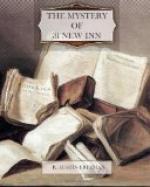“Perfectly; I quite understand it now.”
I went back to my chair and continued to read out the entries from the notebook while Thorndyke laid off the lines of direction with the protractor, taking out the distances with the dividers from a scale of equal parts on the back of the instrument. As the work proceeded, I noticed, from time to time, a smile of quiet amusement spread over my colleague’s keen, attentive face, and at each new reference to a railway bridge he chuckled softly.
“What, again!” he laughed, as I recorded the passage of the fifth or sixth bridge. “It’s like a game of croquet. Go on. What is the next?”
I went on reading out the notes until I came to the final one:
“’Nine twenty-four. South-east. In covered way. Stop. Wooden gates closed.’”
Thorndyke ruled off the last line, remarking: “Then your covered way is on the south side of a street which bears north-east. So we complete our chart. Just look at your route, Jervis.”
He held up the board with a quizzical smile and I stared in astonishment at the chart. The single line, which represented the route of the carriage, zigzagged in the most amazing manner, turning, re-turning and crossing itself repeatedly, evidently passing more than once down the same thoroughfares and terminating at a comparatively short distance from its commencement.
“Why!” I exclaimed, the “rascal must have lived quite near to Stillbury’s house!”
Thorndyke measured with the dividers the distance between the starting and arriving points of the route and took it off from the scale.
“Five-eighths of a mile, roughly,” he said. “You could have walked it in less than ten minutes. And now let us get out the ordnance map and see if we can give to each of those marvellously erratic lines ’a local habitation and a name.’”
He spread the map out on the table and placed our chart by its side.
“I think,” said he, “you started from Lower Kennington Lane?”
“Yes, from this point,” I replied, indicating the spot with a pencil.
“Then,” said Thorndyke, “if we swing the chart round twenty degrees to correct the deviation of the compass, we can compare it with the ordnance map.”
He set off with the protractor an angle of twenty degrees from the north and south line and turned the chart round to that extent. After closely scrutinizing the map and the chart and comparing the one with the other, he said:
“By mere inspection it seems fairly easy to identify the thoroughfares that correspond to the lines of the chart. Take the part that is near your destination. At nine twenty-one you passed under a bridge, going westward. That would seem to be Glasshouse Street. Then you turned south, apparently along the Albert Embankment, where you heard the tug’s whistle. Then you heard a passenger train start on your left; that would be Vauxhall Station. Next you turned round due east and passed under a large railway bridge, which suggests the bridge that carries the Station over Upper Kennington Lane. If that is so, your house should be on the south side of Upper Kennington Lane, some three hundred yards from the bridge. But we may as well test our inferences by one or two measurements.”




